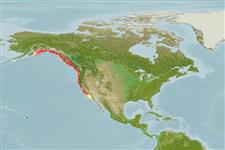Environment: milieu / climate zone / depth range / distribution range
Ecologia
marino demersale; distribuzione batimetrica 110 - 910 m (Ref. 28197). Subtropical; 61°N - 31°N, 165°W - 115°W (Ref. 57306)
North Pacific: Gulf of Alaska to southern California, USA. Evermann and Goldsborough 1907 (Ref. 11366) erroneously recorded Bathyagonus pentacanthus from the Bering Sea.
Size / Peso / Age
Maturity: Lm ? range ? - ? cm
Max length : 23.0 cm TL maschio/sesso non determinato; (Ref. 2850)
Short description
Chiavi di identificazione | Morfologia | Morfometria
Spine dorsali (totale) : 5 - 8; Raggi dorsali molli (totale) : 6 - 7; Spine anali: 0; Raggi anali molli: 6 - 8. Dorsal fins moderately developed and placed fairly close together; caudal rounded; anal originating below interspace between dorsal fin, closer to first; lower 4 or 5 rays of pectorals greatly exserted and thickened; pelvic fins reduced (Ref. 6885). Olive brown on dorsal surface, paler below; 5 or 6 dark brown saddle-like markings on back and sides; dark brown to dusky on dorsal, caudal and pectoral fins; pelvic and anal fins pale (Ref. 6885).
Found on soft bottoms (Ref. 2850).
Life cycle and mating behavior
Maturità | Riproduzione | Deposizione | Uova | Fecundity | Larve
Kanayama, T., 1991. Taxonomy and phylogeny of the family Agonidae (Pisces: Scorpaenifomes). Mem. Fac. Fish. Hokkaido Univ. (38)1-2:1-199. (Ref. 28197)
IUCN Red List Status (Ref. 130435: Version 2024-1)
Threat to humans
Harmless
Human uses
Strumenti
Special reports
Download XML
Fonti Internet
Estimates based on models
Preferred temperature (Ref.
123201): 4.7 - 7.9, mean 5.9 °C (based on 32 cells).
Phylogenetic diversity index (Ref.
82804): PD
50 = 0.5625 [Uniqueness, from 0.5 = low to 2.0 = high].
Bayesian length-weight: a=0.00389 (0.00180 - 0.00842), b=3.12 (2.94 - 3.30), in cm total length, based on all LWR estimates for this body shape (Ref.
93245).
Trophic level (Ref.
69278): 3.2 ±0.4 se; based on size and trophs of closest relatives
Resilienza (Ref.
120179): Medio, tempo minimo di raddoppiamento della popolazione 1.4 - 4.4 anni (Preliminary K or Fecundity.).
Fishing Vulnerability (Ref.
59153): Low vulnerability (13 of 100).
